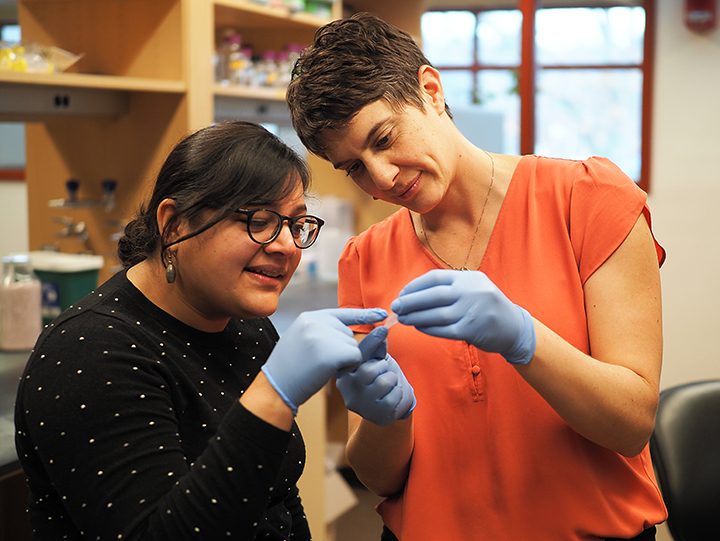This spring, the greenhouses in the Weld Hill Research Building at the Arnold Arboretum of Harvard University will be overflowing with phlox, fragrant flowers bursting with hues of violet, pink, red, and magenta. But it’s not their floral beauty or aroma that captivates Robin Hopkins, assistant professor of organismic and evolutionary biology at Harvard.
Hopkins, who is head of the Hopkins Lab and a Faculty Fellow at the Arboretum, recently received a four-year, $700,000 grant from the National Science Foundation Panel of Plant Biotic Interactions to study how a native Texas phlox species selects its mates. That is, she will work to identify which molecular signals are being stimulated by pollination, and see if the identity of the pollen changes the types of signals being triggered for reproduction.
“The incredible diversity of floral color, shape, smell, and size evolved to entice pollinators to move pollen between plants,” Hopkins said. “But pollinators can be sloppy, and flowers are often bombarded by pollen of all types and variable quality. How do plants pick and choose which pollen to use for reproduction?”
A plant has two important pollen-choice decisions—is the pollen they receive from the same species or a different species, and is the pollen from the same plant or a different plant? Pollen from the wrong individual can result in weak seeds, or offspring that are unable to grow and reproduce. Hopkins will use her lab’s focal study plant, Phlox drummondii (annual phlox,) to highlight the molecular signals it uses to highlight which pollen has the best chance of making a successful offspring.
Early work suggests that the two pollen-choice decisions could rely on the same molecular signals. Hopkins is working with two postdoctoral researchers and a research technician who will be replicating the activities of pollinators to test the strength of pollen identification mechanisms.

“What is particularly exciting is that individuals may use similar, if not the same, mechanisms to identify and reject pollen for many different reasons,” she said.
Hopkins’ research is inspired by the concept of evolution, how biological diversity forms, and how species interactions result in evolutionary outcomes. She aims to understand specifically how different species in the Phlox genus, wildflowers native to North America, can geographically coexist and sometimes reproduce.
“Most plants depend on pollinators to successfully set seeds,” Hopkins said. “In some areas of Texas, Phlox drummondii grows together with Phlox cuspidata (pointed phlox) and is bombarded with pollen from this closely related, but different species. This can result in hybrid offspring that are sterile and cannot reproduce. The goal of this research is to determine how an individual identifies and rejects the pollen that will make a bad seed.”
William (Ned) Friedman, director of the Arnold Arboretum and Arnold Professor of Organismic and Evolutionary Biology at Harvard noted that “mate choice” in plants is one of the most interesting topics being studied in modern evolutionary biology.
“Far too few people realize how incredibly sophisticated plants are at the molecular level when it comes to which sperm get to pair with an egg and sire the next generation,” he said. “Robin has a spectacular study system and the results of this research will almost certainly end up as classic examples of the evolutionary process.”
This work builds on Hopkins’s ongoing research about what causes and maintains the differences between species. Earlier this year Hopkins received a $1.3 million grant from the National Science Foundation’s Faculty Early Career Development Program to study the process of speciation—how phlox lineages evolve to become distinct species. She is also developing a research experience for first-year Harvard College students to learn molecular lab skills and use research tools that may not have been available in their high school classrooms.
Antonio Serrato-Capuchina, who joined the Hopkins lab in September, said it’s exciting to work at the Arboretum to address longstanding biological questions using both modern and classical techniques.
“We are interested in dissecting whether there is a conserved ‘toolkit’ that serves to aid the evolution of mate recognition systems,” he said. “Any patterns we see can have broader implications regarding the potential of organisms to adapt to a changing world.”
From “free” to “friend”…
Established in 1911 as the Bulletin of Popular Information, Arnoldia has long been a definitive forum for conversations about temperate woody plants and their landscapes. In 2022, we rolled out a new vision for the magazine as a vigorous forum for tales of plant exploration, behind-the-scenes glimpses of botanical research, and deep dives into the history of gardens, landscapes, and science. The new Arnoldia includes poetry, visual art, and literary essays, following the human imagination wherever it entangles with trees.
It takes resources to gather and nurture these new voices, and we depend on the support of our member-subscribers to make it possible. But membership means more: by becoming a member of the Arnold Arboretum, you help to keep our collection vibrant and our research and educational mission active. Through the pages of Arnoldia, you can take part in the life of this free-to-all landscape whether you live next door or an ocean away.

